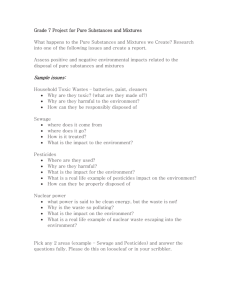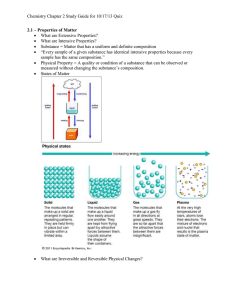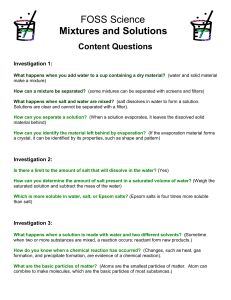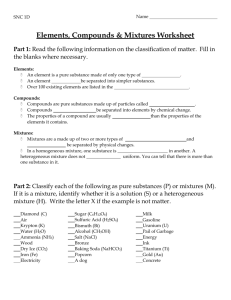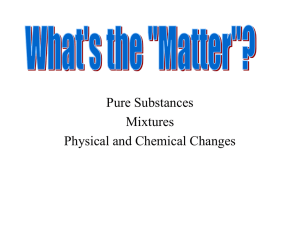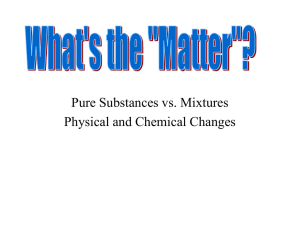Heterogenous Mixtures
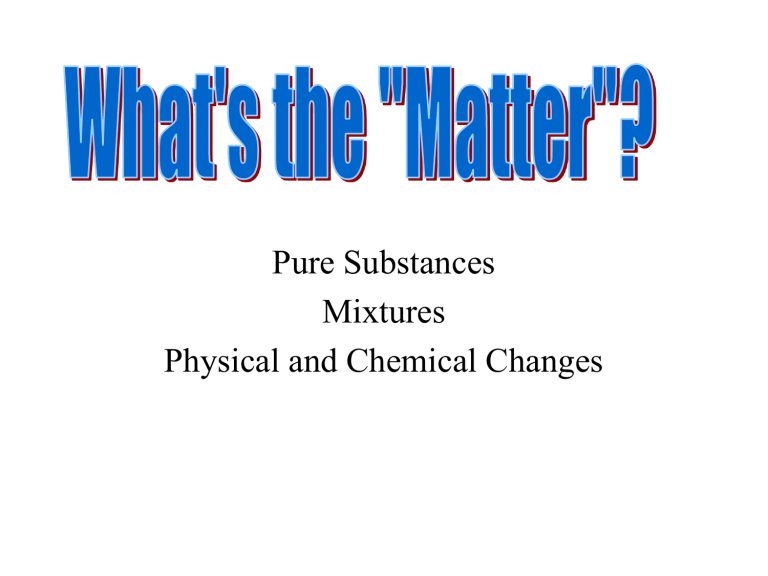
Pure Substances
Mixtures
Physical and Chemical Changes
Everything that has mass and volume is called matter.
Matter that has a fixed composition and definite properties . (chemical and physical)
There are two kinds of pure substances
Elements
Compounds
Elements
• Substance that cannot be separated or broken down into simpler substances by chemical means.
• Ex’s- any box on the periodic table
• Made of only 1 type of atom
– The smallest unit of an element that maintains the properties of that element
• HUH?
The smallest unit of an element that maintains the properties of that element???
• The element sodium has certain properties
– 11 protons, 11 electrons…boiling point, etc
Compounds
• Substance made of atoms of 2 or more different elements that are CHEMICALLY combined.
• Always have a chemical formula to represent it
• Elements are combined in a definite way and this changes their properties
Na
- lethal if ingested
Cl lethal if ingested
NaCltable salt
Compounds
• Can be decomposed into simpler substances by chemical changes, always in a definite ratio
NaCl
(sodium chloride/salt)
Elements
• Cannot be decomposed into simpler substances by chemical changes
Na
(sodium)
• Fixed composition
• Cannot be separated into simpler substances by physical methods (physical changes)
• Can only be changed in identity and properties by chemical methods
• Properties do not vary
• Can be expressed with a chemical formula
– Ex H2O, NaCl, H
•
Mixtures are two or more substances that are physically combined.
•
(NOT chemically combined like a pure substance)
•
May be separated into pure substances by physical methods
Examples of Mixtures
• Components retain their characteristic properties and can be separated by physical means.
• http://videos.howstuffworks.com/hsw/22540-together-but-separatesuspensions-video.htm
This sand and iron filings mixture can be separated using a magnet.
Two types of mixtures
•
Homogenous mixtures look the same throughout
•
Types: solutions, alloys, etc.
•
Example: salt water, brass
• Have the same composition throughout
• Components are indistinguishable
• May or may not scatter light
• Particle size is small
Can they still be separated by physical means ?
YES!!! It may be more complicated, but it can be done…distillation , centrifugation
• Solutions are …
• homogenous mixtures that do not scatter light .
• separated by distillation or evaporation.
• created when something is completely dissolved in pure water.
Examples: sugar water, salt water
Parts of a Solution
•
Solute- substance that dissolves in solvent ex. Salt (“U dissolve”)
•
Solvent- substance that does the dissolving
(ex.water)
Well, not really, because you don’t dissolve, but you get the picture
Why don’t you dissolve?
• You are not “Miscible”
– Miscible- two or more liquids that can dissolve into each other
– Immiscible- liquids that do NOT mix
• Ex- oil and water
Heterogeneous mixtures are composed of large pieces that are easily separated by physical means (ie. density, polarity, metallic properties).
• Do not have same composition throughout
• Components are distinguishable
• Particle size is medium or large
Examples: fruit salad, vegetable soup, etc.
Tyndall Effect
• Light scattering caused by particles
• Types of heterogeneous mixtures include:
• Colloid –medium particles
• Suspension-large particles
Colloids are heterogeneous mixtures. They can be described as a substance trapped inside another substance. They can be identified by their characteristic scattering of light.
For example: air trapped inside the fat molecules in whipped cream, mayonnaise,
• A property of suspensions is that the particles will settle out when the mixture is allowed to stand
• Ex. Orange juice with pulp, muddy water

